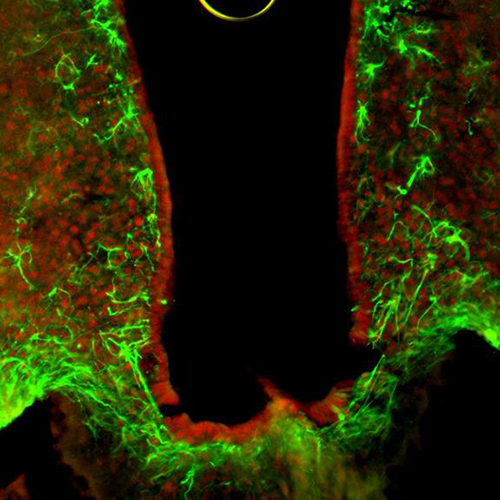![Histone deacetylase 5 (HDAC5) has been identified as a key factor in neurons for the control of food intake. The enzyme appears to influence leptin signaling through its interaction with a transcription factor called STAT3. In this image, HDAC5 appears in red and astrocytes are shown in green. [Helmholtz Zentrum München]](https://genengnews.com/wp-content/uploads/2018/08/Mar1_2016_HelmholtzZentrumMunchen_HDAC55615238243-1.jpg)
Histone deacetylase 5 (HDAC5) has been identified as a key factor in neurons for the control of food intake. The enzyme appears to influence leptin signaling through its interaction with a transcription factor called STAT3. In this image, HDAC5 appears in red and astrocytes are shown in green. [Helmholtz Zentrum München]
Scientists have identified a key component of the genetic circuitry that controls food intake. This component, an enzyme called histone deacetylase 5 (HDAC5), interacts with leptin, a hormone secreted by fat tissue. Without adequate HDAC5, leptin fails to trigger the satiety response in the brain, and food intake is sustained. The result is a shift in the body’s energy balance and an increase in body weight and fat storage, possibly leading to obesity and type 2 diabetes.
Ordinarily, HDAC5 is increased by a high-fat diet (HFD), enlarged fat deposits, and the satiety hormone leptin. Yet HDAC5 is not always produced in adequate amounts. Initial studies in mice have shown that mice unable to produce HDAC5 respond significantly worse to leptin. These mice show leptin resistance, a continuously increased food intake, and, in comparison to mice with intact HDAC5, increased obesity. That is, they get fat.
Targeted activation of HDAC5, reasoned a team of researchers based at the Helmholtz Diabetes Center, Helmholtz Zentrum München, might reverse leptin resistance and thereby enable obese animals to lose fat mass and body weight. These researchers, led by Paul Pfluger and Matthias H. Tschöp, decided to manipulate HDAC5 production and evaluate the effects on leptin signaling and the regulation of body weight in mice.
The results of this work appeared February 29 in the journal Nature Communications, in an article entitled, “Hypothalamic Leptin Action Is Mediated by Histone Deacetylase 5.” The article indicated that global HDAC5 knockout mice have increased food intake and greater diet-induced obesity when fed a HFD. It also noted that pharmacological and genetic inhibition of HDAC5 activity in the mediobasal hypothalamus increases food intake and modulates pathways implicated in leptin signaling.
“We show HDAC5 directly regulates STAT3 localization and transcriptional activity via reciprocal STAT3 deacetylation at Lys685 and phosphorylation at Tyr705,” wrote the authors. “In vivo, leptin sensitivity is substantially impaired in HDAC5 loss-of-function mice. Hypothalamic HDAC5 overexpression improves leptin action and partially protects against HFD-induced leptin resistance and obesity.”
Essentially, the researchers showed that HDAC5 deacetylates the transcription factor signal transducer and activator of transcription 3 (STAT3), whereupon STAT3 can migrate to the leptin receptor. If STAT3 is phosphorylated (activated) there, it migrates back to the cell nucleus and binds to the DNA to activate gene and behavior programs that ultimately cause the reduction of food intake.
If HDAC5 is absent (such as here, after genetic deletion), STAT3 accumulates as a hyperacetylated, and thus inactive, protein in the cell nucleus. The leptin signaling pathway is thus switched off, subsequently suppressing the feeling of satiety.
“The restoration of leptin sensitivity is an important step on the path towards sustainable weight loss and towards combating potential sequelae of obesity such as type 2 diabetes,” said Dr. Pfluger. “In addition to the essential changes in diet and exercise behavior, in the future the individual components of the leptin effect could be potential drug targets to support the weight loss process.” One of these essential components, HDAC5, has already been identified. “However,” Dr. Pfluger concluded, “it remains to be seen in the coming years whether this enzyme will be a suitable target for combating obesity in humans.”



